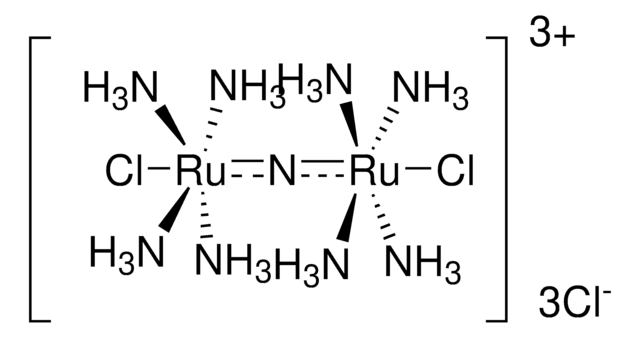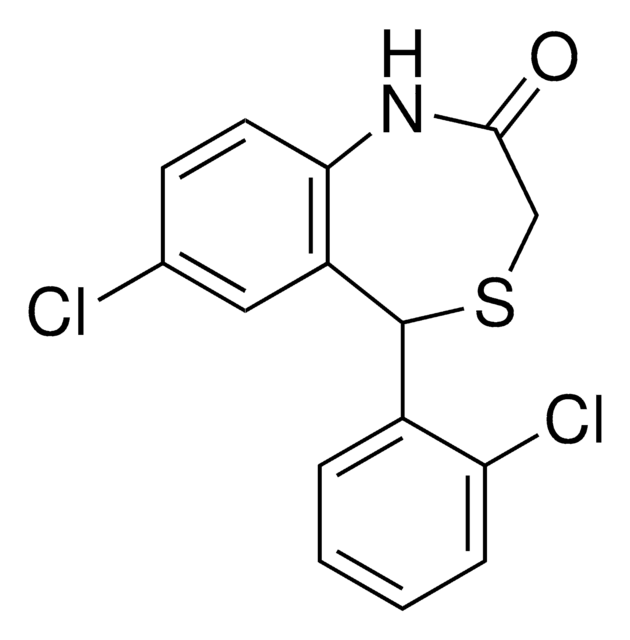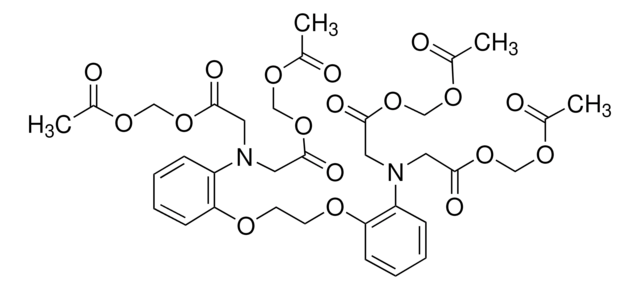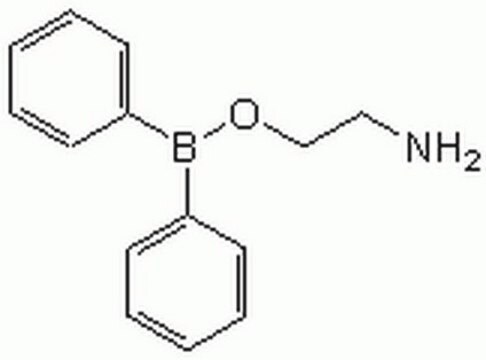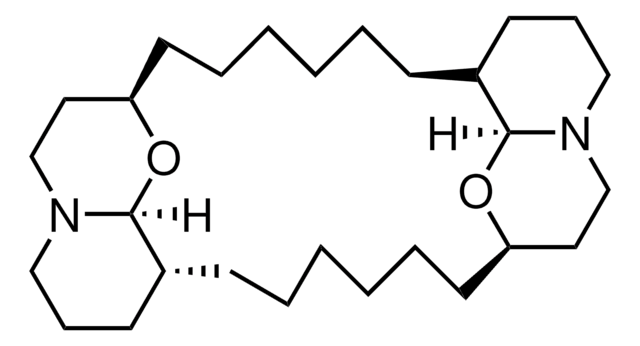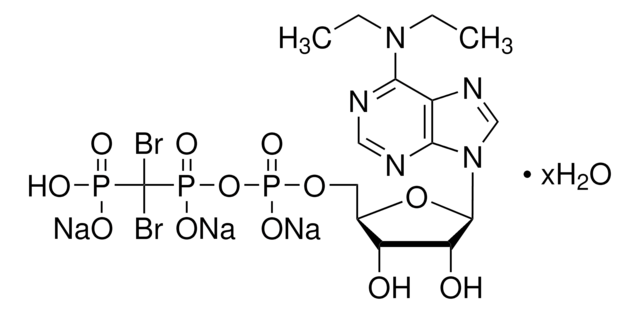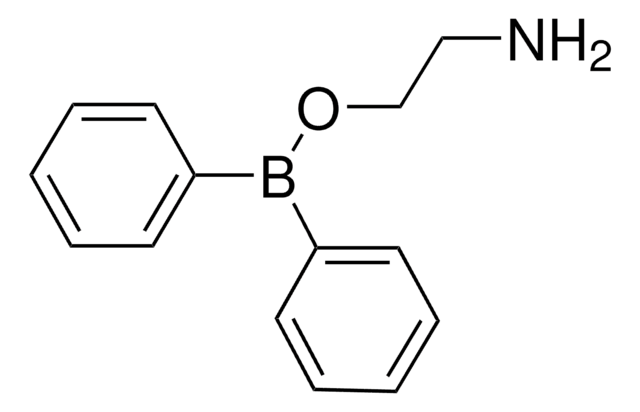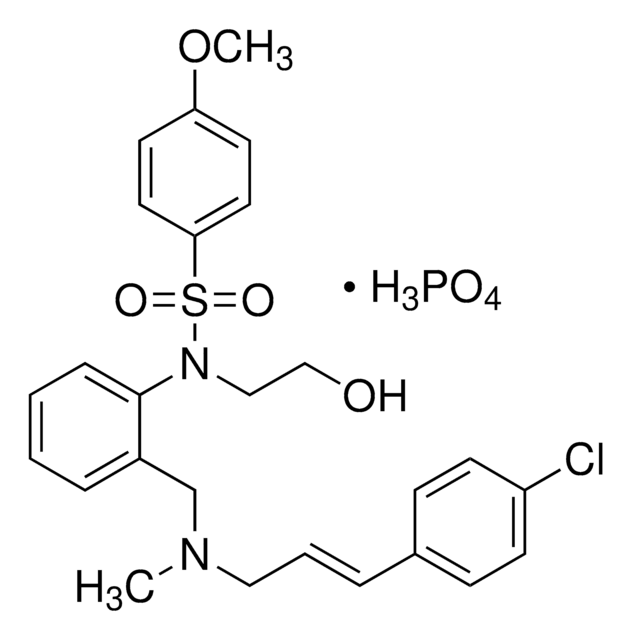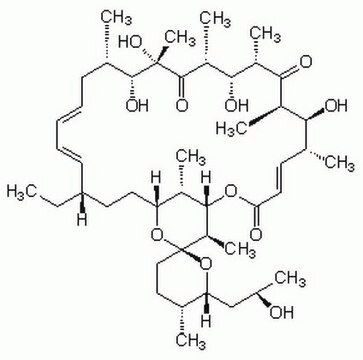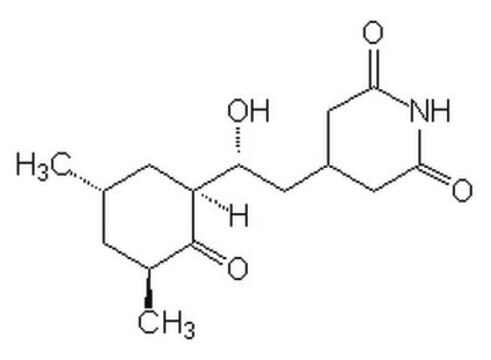557440
Ru360
Ru360, is a cell-permeable oxygen-bridged dinuclear ruthenium amine complex. Binds to mitochondria with high affinity (Kd = 340 pM) and blocks Ca2+ uptake into mitochondria in vitro (IC₅₀ = 184 pM).
Synonym(s):
Ru360, (μ)[(HCO₂)(NH₃)₄Ru]₂OCl₃
Sign Into View Organizational & Contract Pricing
All Photos(1)
About This Item
Empirical Formula (Hill Notation):
C2H26Cl3N8O5Ru2
Molecular Weight:
550.78
UNSPSC Code:
12352200
Recommended Products
Quality Level
Assay
≥97%
form
solid
manufacturer/tradename
Calbiochem®
storage condition
OK to freeze
desiccated (hygroscopic)
protect from light
color
green
solubility
deoxygenated water: 0.5 mg/mL
shipped in
ambient
storage temp.
−20°C
General description
A cell-permeable oxygen bridged dinuclear ruthenium amine complex that has been shown to bind to mitochondria with high affinity (Kd = 0.34 nM) and specifically blocks Ca2+ uptake into mitochondria in vitro (IC50 = 184 pM) and in situ in intact myocytes (for complete block after incubation with ~10 µM of Ru360 for 30 min. Does not affect other cellular Ca2+ transport processes involved in cardiac muscle contraction even at micromolar levels.
A cell-permeable oxygen-bridged dinuclear ruthenium amine complex that has been shown to bind to mitochondria with high affinity (Kd = 340 pM). Specifically blocks Ca2+ uptake into mitochondria in vitro (IC50 = 184 pM) and in situ in intact myocytes (complete block after incubation with ~10 µM of Ru360 for 30 min). Does not affect other cellular Ca2+ transport processes involved in cardiac muscle contraction, even at micromolar levels.
Note: 1 set = 10 x 100 µg.
Biochem/physiol Actions
Cell permeable: yes
Primary Target
Ca2+ uptake into mitochondria in vitro
Ca2+ uptake into mitochondria in vitro
Product does not compete with ATP.
Reversible: no
Target IC50: 184 pM blocking Ca2+ uptake into mitochondria in vitro; and in situ in intact myocytes; Kd = 340 pM for binding mitochondria
Packaging
Packaged under inert gas
Warning
Toxicity: Standard Handling (A)
Reconstitution
Unstable in solution; reconstitute just prior to use.
Other Notes
Sanchez, J.A., et al. 2001. J. Physiol. 536, 387.
Bassani, R.A., et al. 1998. Cell Calcium23, 433.
Matlib, M.A., et al. 1998. J. Biol. Chem.273, 10223.
Zhou, Z., et al. 1998. J. Physiol.507 (pt 2), 379.
Emerson, J., et al. 1993. J. Am. Chem. Soc.115, 11799.
Ying, W.-L., et al. 1991. Biochemistry30, 4949.
Bassani, R.A., et al. 1998. Cell Calcium23, 433.
Matlib, M.A., et al. 1998. J. Biol. Chem.273, 10223.
Zhou, Z., et al. 1998. J. Physiol.507 (pt 2), 379.
Emerson, J., et al. 1993. J. Am. Chem. Soc.115, 11799.
Ying, W.-L., et al. 1991. Biochemistry30, 4949.
Legal Information
CALBIOCHEM is a registered trademark of Merck KGaA, Darmstadt, Germany
Storage Class Code
11 - Combustible Solids
WGK
WGK 1
Flash Point(F)
Not applicable
Flash Point(C)
Not applicable
Certificates of Analysis (COA)
Search for Certificates of Analysis (COA) by entering the products Lot/Batch Number. Lot and Batch Numbers can be found on a product’s label following the words ‘Lot’ or ‘Batch’.
Already Own This Product?
Find documentation for the products that you have recently purchased in the Document Library.
Customers Also Viewed
Lianne Pope et al.
Cell chemical biology, 27(5), 511-524 (2020-02-16)
The trinuclear ruthenium amine ruthenium red (RuR) inhibits diverse ion channels, including K2P potassium channels, TRPs, the calcium uniporter, CALHMs, ryanodine receptors, and Piezos. Despite this extraordinary array, there is limited information for how RuR engages targets. Here, using X-ray
Wenbo Zhu et al.
Frontiers in microbiology, 13, 861734-861734 (2022-04-02)
Human cytomegalovirus (HCMV) infection can induce apoptosis of vascular endothelial cells, which may be the most important element of development and progression of reported atherosclerosis caused by HCMV. As there are no specific drugs to clear HCMV infection, exploration of
Rachel A Hutto et al.
Cell death and differentiation, 27(3), 1067-1085 (2019-08-03)
Photoreceptors are specialized neurons that rely on Ca2+ to regulate phototransduction and neurotransmission. Photoreceptor dysfunction and degeneration occur when intracellular Ca2+ homeostasis is disrupted. Ca2+ homeostasis is maintained partly by mitochondrial Ca2+ uptake through the mitochondrial Ca2+ uniporter (MCU), which
Miguel Olivas-Aguirre et al.
International journal of molecular sciences, 22(1) (2021-01-01)
Anticancer activity of different phenols is documented, but underlying mechanisms remain elusive. Recently, we have shown that cannabidiol kills the cells of acute lymphoblastic leukemia (ALL) by a direct interaction with mitochondria, with their consequent dysfunction. In the present study
Our team of scientists has experience in all areas of research including Life Science, Material Science, Chemical Synthesis, Chromatography, Analytical and many others.
Contact Technical Service